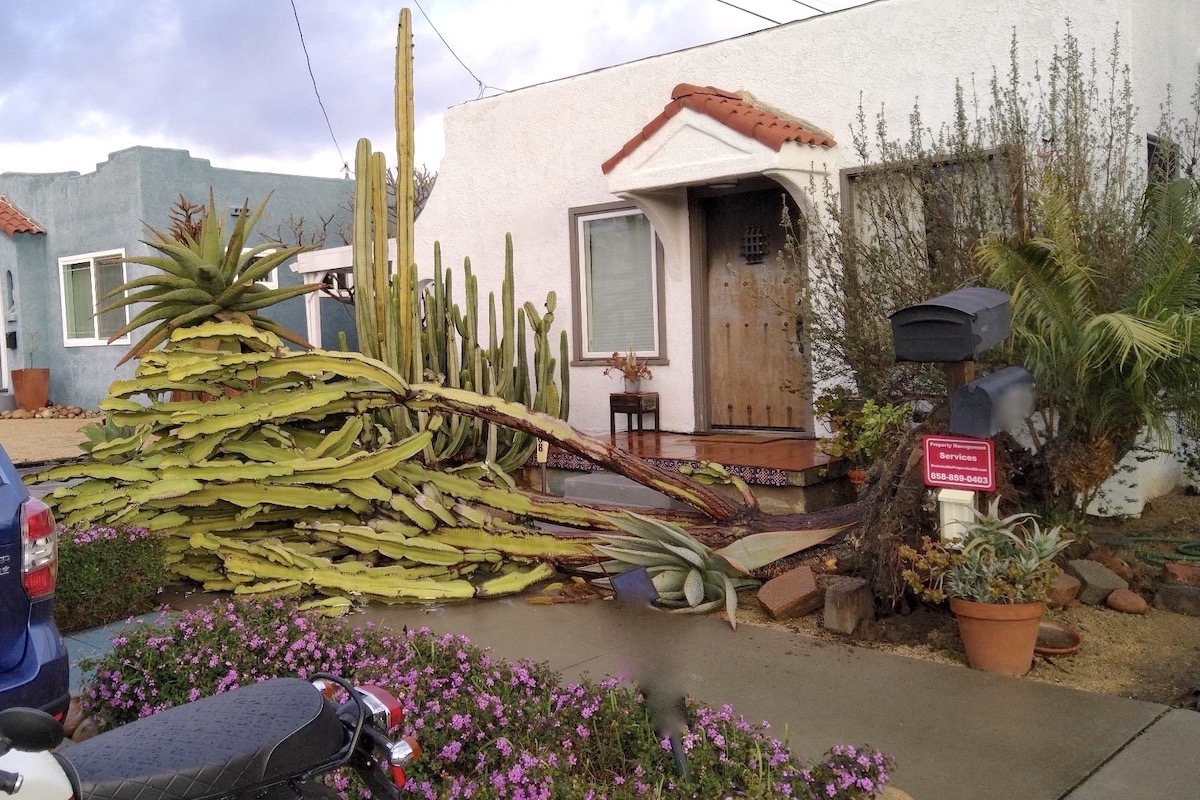
Oh No! My Succulent Fell Over!
Sean Mazelli of San Diego's South Park neighborhood emailed: "Hi Debra, hopefully you can help. I have a huge cactus that fell over. I just loved it, in fact it was a big reason why I bought the house."

Euphorbia ammak 'Variegata' before it fell over (house photos by Sean Mazelli, San Diego EcoRentals)
My first thought was that the base of the trunk had rotted, but that proved not to be the case. Like most succulents, this one was shallow-rooted and consequently not well anchored. Several weeks of rainy weather had softened the soil and engorged the limbs, making the plant top-heavy and unstable.
Btw, it’s not a cactus but Euphorbia ammak from South Africa (cacti are indigenous to the Americas). Regardless, when such plants crash, they proceed to do what succulents are known for: grow from pieces.
Hi-ho, a-propagating we will go
Unlike woody trees and shrubs, succulent leaves and stems contain all they need to form new plants. How fallen specimens do this is intriguing and remarkable. Some examples:
Clones feed off dying parent
Below, the bleached body of a Cereus peruvianus rests beside the hole in which it once grew. Do you think it's wonderful or awful? Would you want it in your garden? (I would---great conversation piece.)

Cactus offsets grow from a toppled parent plant. What do you think? Is it still alive?
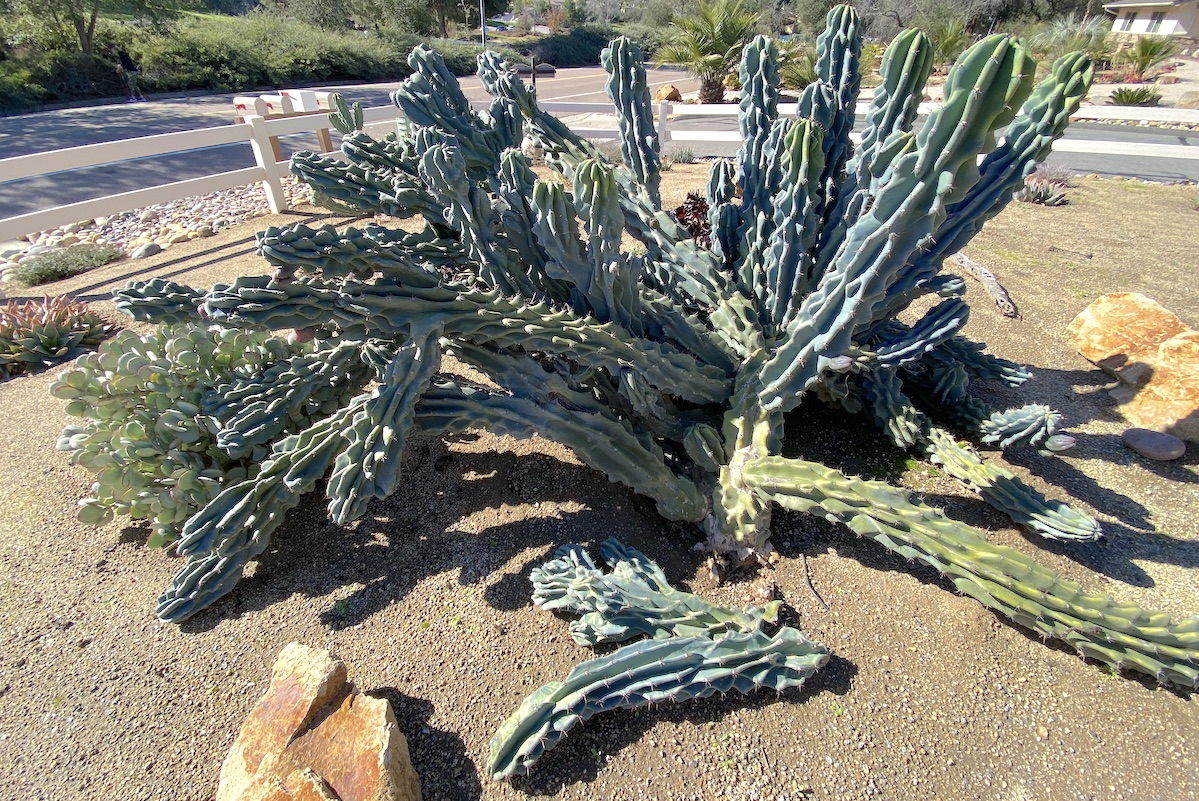
After a storm, engorged limbs of Cereus peruvianus 'Monstrosus' (blue form) broke off the plant's trunk
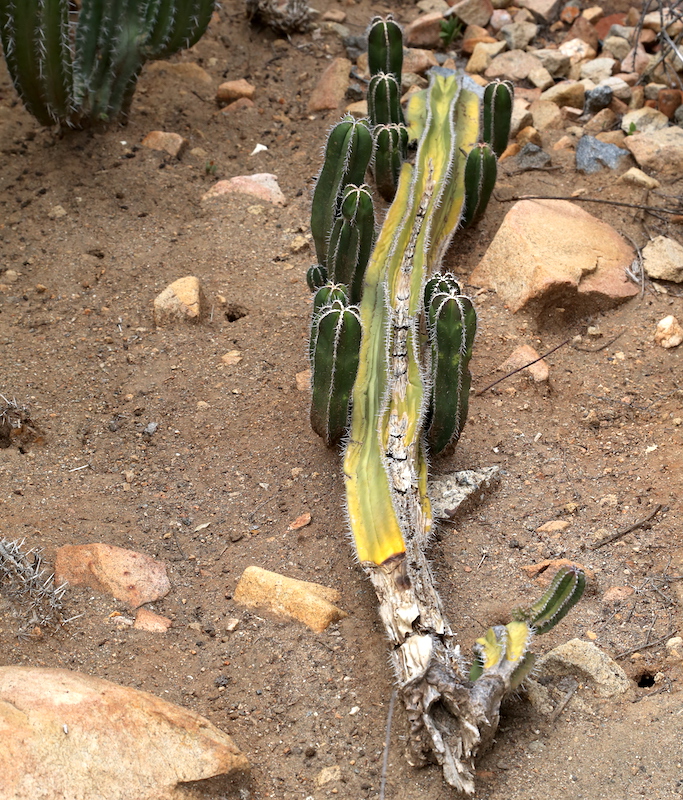
Clones thrive along a fallen Lemaireocereus marginata. The tendency of plants to grow toward the sun is "phototropism."
Below: When a barrel cactus growing on a slope uproots and rolls, the poor thing ends up like an overturned turtle.
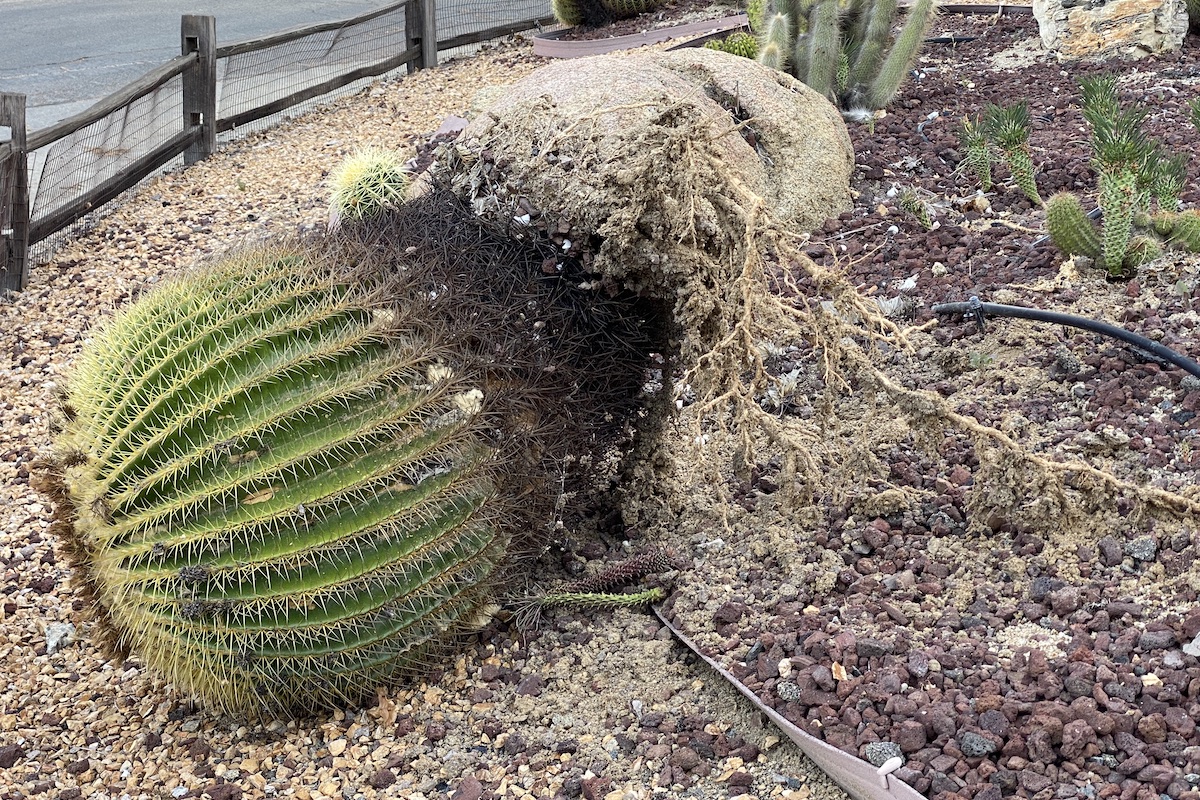
After its tumble, owners hoisted and replanted this golden barrel, which now is doing fine.
Cacti and euphorbias aren't the only ones
Below: Offsets of leaning Agave attenuata specimens grow from stems exposed to sunlight.
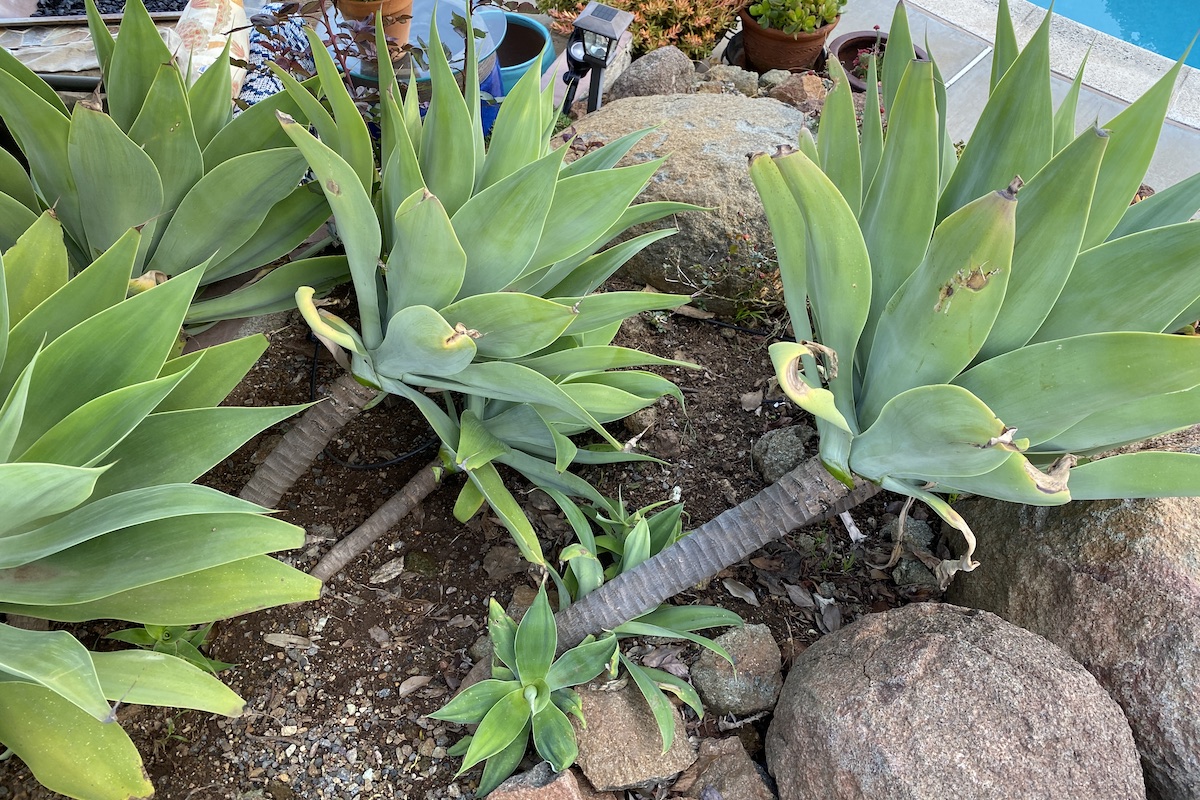
Agave attenuata, atypical of the genus, is trunk-forming.
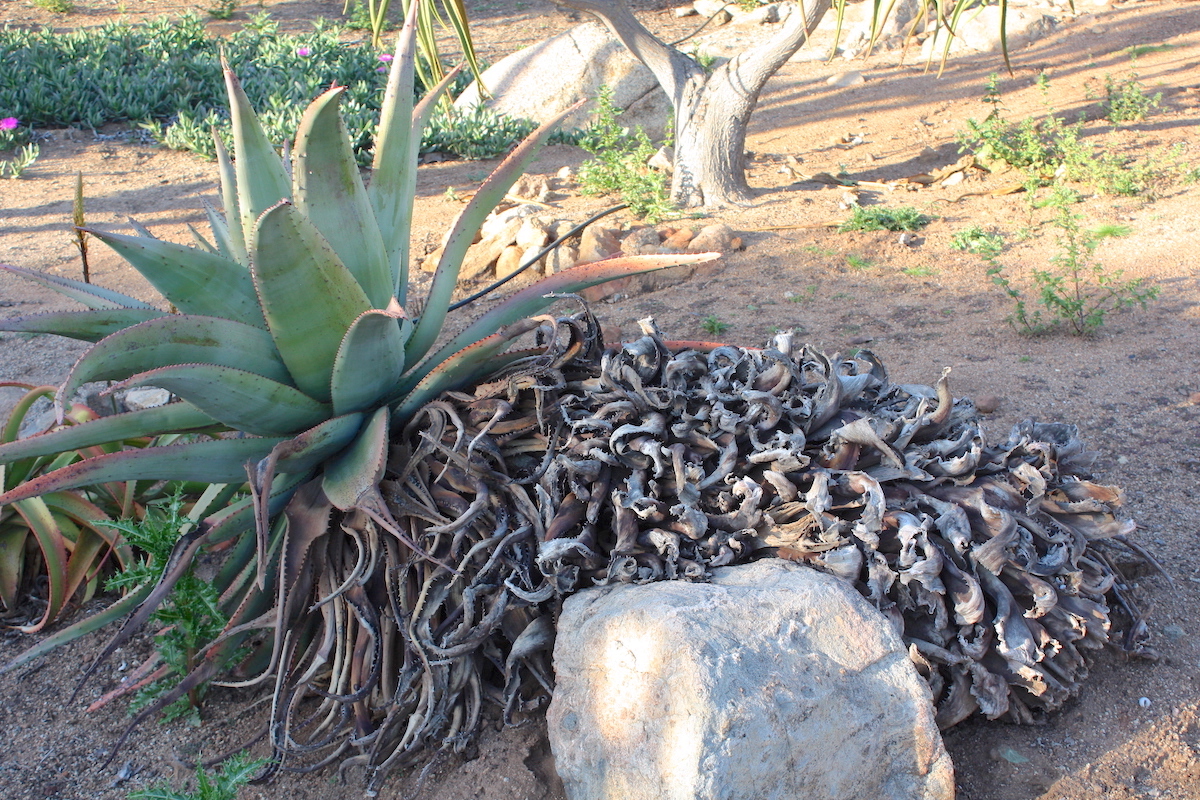
Fallen-over Aloe ferox
Small succulents tumble too
If you, like me, don't always bother to cut back and replant ever-lengthening succulents, they may take matters into their own hands and trapeze out of their pots.
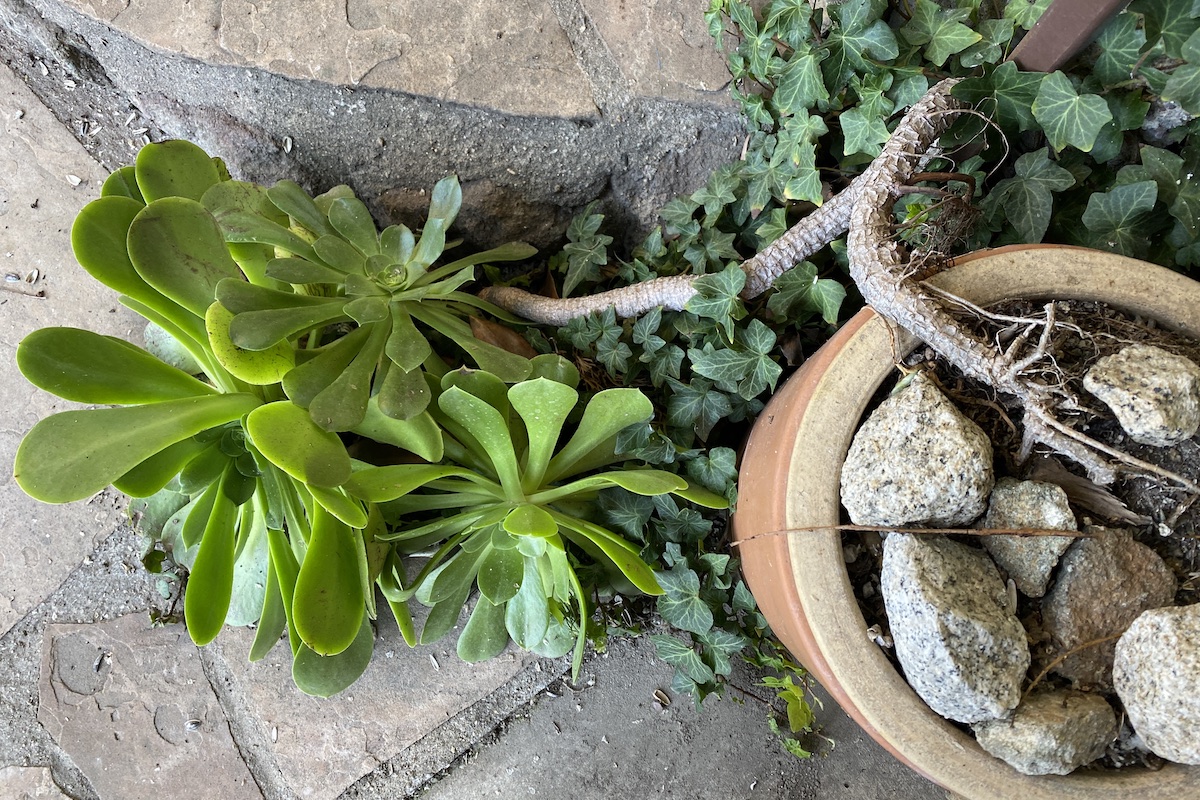
A leggy aeonium escaped its container. Note exposed roots.
Did you happen to see my post and video on planting succulents in windowsill pots? They're now four years old, and I've yet to redo them. If I hadn't weighed the pots with stones, stems tipped with plump rosettes would have overturned the containers.
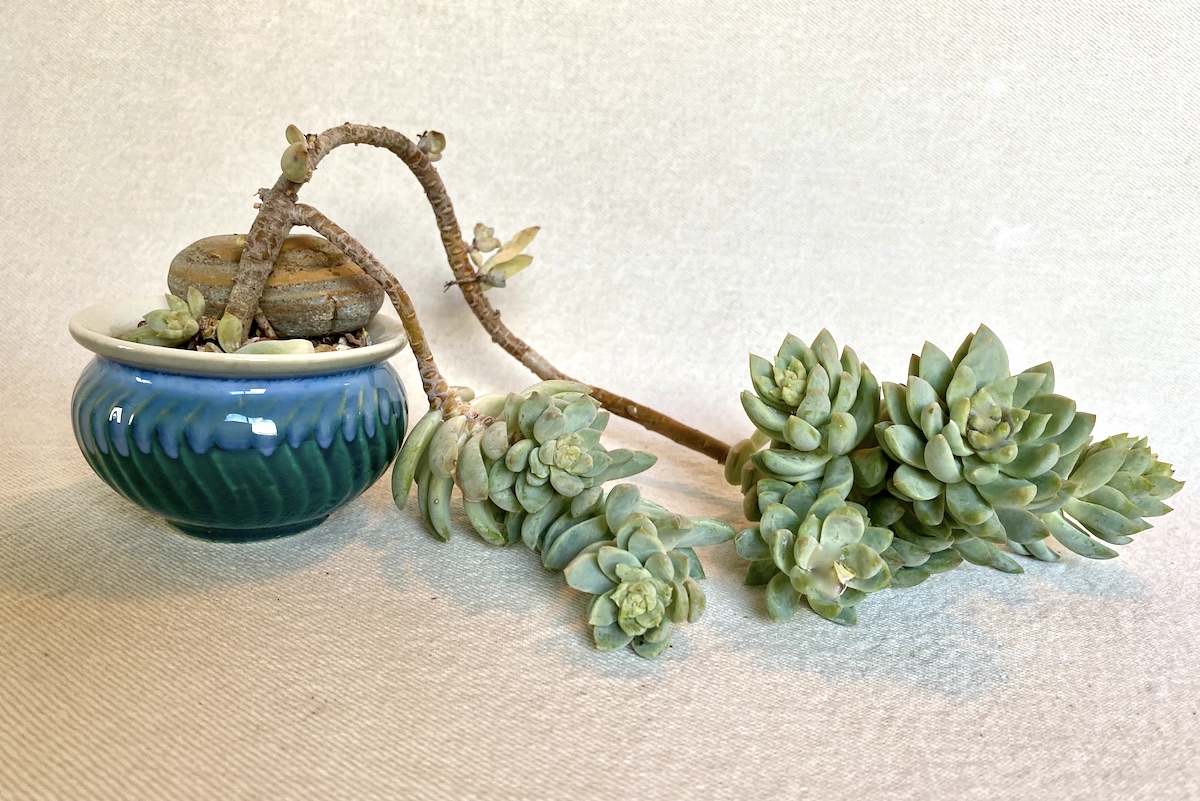
See how this sedeveria looked when first planted, in my Succulent Windowsill Pots DIY
So, what should Sean do?
"I have a contractor who says he could probably prop it back up," Sean told me. "Do you think that’s a good idea?"

Euphorbia ammak 'Variegata' at Desert Theater nursery were planted in 2005 and 2006
I showed his photos to Brandon Bullard, owner of Desert Theater nursery, where similarly sized euphorbias grow in the ground. Of Sean's he said, “No way is is that going to go upright again.”
Brandon added that the fallen tree is a wonderful source of cuttings. He suggested Sean plant a 4 or 5-foot-long “candelabra piece” where the original plant was.
"That sounds like a win-win," Sean agreed, adding, "I do have some friends that would want cuttings. It would be nice to know that I helped create more plants instead of just getting rid of them."

Euphorbia ammak 'Variegata' in a different location, tied upright. Good idea, but I'd conceal the strap by painting it the same color as the plant.
Keep in Mind
- If you have a top-heavy succulent, thin it out, ideally before winter storms. Plant or share the cuttings.
- If a tree succulent has a V-shape with a narrow base, strap it to a nearby structure or to metal posts in the ground.
- In a pinch, prop it with 2x4s or plant stakes.
- When pruning euphorbias, watch out for milky sap. See my euphorbia-pruning video.
- Caution: Greater hydraulic pressure after storms increases sap flow and volume.
- Once soil dries and limbs return to their pre-storm girth, shallow-rooted succulents will be less prone to toppling.
Related Info on This Site
Euphorbia or Cactus? How to Tell
How can you tell a spiny euphorbia from a cactus? Observe key characteristics: the type of spines, flowers and leaves (or lack thereof). As I compiled my site’s new Euphorbia page, I happily acquired the ability to tell at a glance which is which. Sure, you can scratch a plant, and if it drips milky sap, it’s
Succulent Rainstorm Checklist
Succulents love rain but some may be in danger of getting too much. Here’s my own Succulent Rain Checklist for in-ground and potted succulents, plus a Succulent Rain Gallery

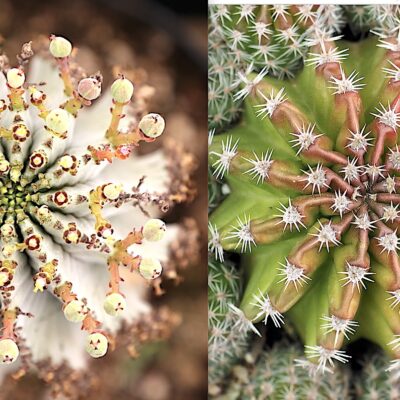

Wonderful photo examples and great advice to Sean. His Euphorbia is stunning and now it will be shared!
Yes, it’s a win-win for Sean, his friends and for the plant, too!
Thanks Debra for all of the help!!!
Come stay at one of our Sustainable Properties
http://www.sandiegoecorentals.com Short Term
http://www.sustainablepropertiesSD.com Long term
We have a beautiful Euphorbia ingens in our patio area. Every few years, when it gets about 9 or 10 feet tall, we choose the best looking offshoot, cut it off and stick it in the ground once we remove the mother plant. It was hard to do the first time (will it work?) but now I know that it keeps our plant healthy and happy. It is a wonderful succulent that keeps on giving.
Janis, that’s brilliant! I can imagine it too courage the first time. What a great validation for Brandon’s advice.
I have seen so many CA succulents toppled over from all the rain this winter. So difficult but I think the answer here is the best one. Replant cuttings from the original and go on from there. Luckily here in my area we haven’t gotten so much rain that the plants are toppling!
However, “Euphorbia ammak ‘Variegata’ in a different location, tied upright” to me is not in a good place. I think it is too big for there and I don’t care for the straps (even if planted the same color as the plant). But to each his own!
I agree. Not a great location to begin with. Plus it’s leaning toward the sun!
I’d love to see some “after” photos of Sean’s euphorbia. I hope you can do a follow up on how he salvaged his tree. Thanks, Debra, another great newsletter!
xo
Cathy
Yes! Great idea. Thanks, Cathy!
I saw that same euphorbia on the sidewalk there in South Park when I was showing the property for sale next door (I’m a real estate broker). Glad Sean is going to get a piece back up and use the rest for friends! I was wondering what would happen with it😊
Very cool, Susan, that you saw it, were wondering, and now you know!
Hi! I live in Los Angeles and with all the rain we’ve been getting my beautiful large potted jade has just started leaning to one side. It doesn’t look like root rot, but maybe it’s starting? Curious if you have any suggestions how I can save her?? Thank you in advance!!
Hi Emily — It may be top-heavy from new growth or its roots have rotted. If the latter, cut well above the diseased tissue, let the cut end callus (dry and heal) and plant in fresh soil so it stands upright and at least one of the bands around the trunk are covered (that’s where new roots will form. Branches and leaves may droop, but they’ll recover once roots are able to pump water and nutrients into them.